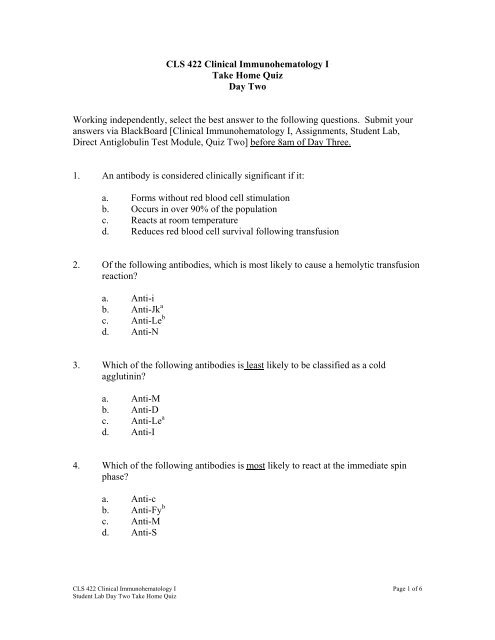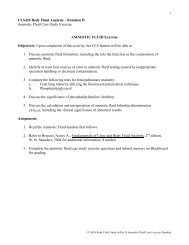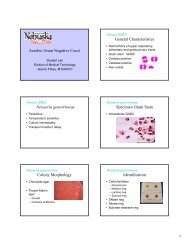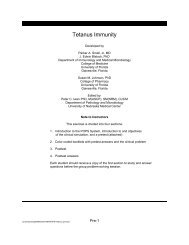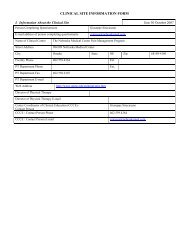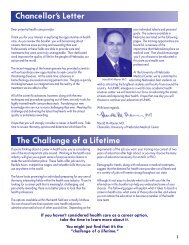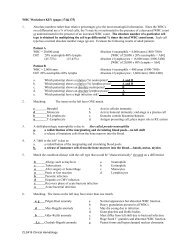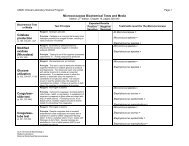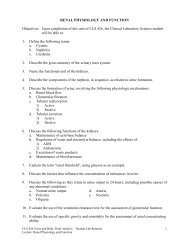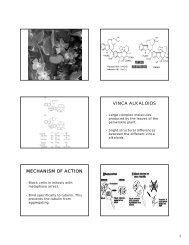CLS 422 Clinical Immunohematology I Take Home Quiz Day Two ...
CLS 422 Clinical Immunohematology I Take Home Quiz Day Two ...
CLS 422 Clinical Immunohematology I Take Home Quiz Day Two ...
You also want an ePaper? Increase the reach of your titles
YUMPU automatically turns print PDFs into web optimized ePapers that Google loves.
<strong>CLS</strong> <strong>422</strong> <strong>Clinical</strong> <strong>Immunohematology</strong> I<br />
<strong>Take</strong> <strong>Home</strong> <strong>Quiz</strong><br />
<strong>Day</strong> <strong>Two</strong><br />
Working independently, select the best answer to the following questions. Submit your<br />
answers via BlackBoard [<strong>Clinical</strong> <strong>Immunohematology</strong> I, Assignments, Student Lab,<br />
Direct Antiglobulin Test Module, <strong>Quiz</strong> <strong>Two</strong>] before 8am of <strong>Day</strong> Three.<br />
1. An antibody is considered clinically significant if it:<br />
a. Forms without red blood cell stimulation<br />
b. Occurs in over 90% of the population<br />
c. Reacts at room temperature<br />
d. Reduces red blood cell survival following transfusion<br />
2. Of the following antibodies, which is most likely to cause a hemolytic transfusion<br />
reaction?<br />
a. Anti-i<br />
b. Anti-Jk a<br />
c. Anti-Le b<br />
d. Anti-N<br />
3. Which of the following antibodies is least likely to be classified as a cold<br />
agglutinin?<br />
a. Anti-M<br />
b. Anti-D<br />
c. Anti-Le a<br />
d. Anti-I<br />
4. Which of the following antibodies is most likely to react at the immediate spin<br />
phase?<br />
a. Anti-c<br />
b. Anti-Fy b<br />
c. Anti-M<br />
d. Anti-S<br />
<strong>CLS</strong> <strong>422</strong> <strong>Clinical</strong> <strong>Immunohematology</strong> I Page 1 of 6<br />
Student Lab <strong>Day</strong> <strong>Two</strong> <strong>Take</strong> <strong>Home</strong> <strong>Quiz</strong>
5. Which of the following antibodies typically shows enhanced reactivity with<br />
enzyme treated red blood cells?<br />
a. Anti-Fy a<br />
b. Anti-Jk a<br />
c. Anti-N<br />
d. Anti-s<br />
6. Which of the following could be classified as a low prevalence antigen?<br />
a. I<br />
b. Jk b<br />
c. K<br />
d. s<br />
7. An anti-Jk a that is showing dosage will react strongest with which of the<br />
following cells?<br />
a. Jk(a+b+)<br />
b. Jk(a+b-)<br />
c. Jk(a-b+)<br />
d. Jk(a-b-)<br />
8. The purpose of performing the antibody screen is to detect clinically significant<br />
______________:<br />
a. Alloantibodies<br />
b. Autoantibodies<br />
c. Expected ABO antibodies<br />
d. Heterophile antibodies<br />
9. Antibody screening cell sets are comprised of RBCs from which ABO group?<br />
a. A<br />
b. B<br />
c. O<br />
d. Any ABO group is acceptable<br />
10. What phases of testing must be included in the antibody screen?<br />
a. 37 o C & AHG<br />
b. Immediate spin, 37 o C & AHG<br />
c. Immediate spin, room temperature & check cells<br />
d. Tube, gel, solid phase<br />
<strong>CLS</strong> <strong>422</strong> <strong>Clinical</strong> <strong>Immunohematology</strong> I Page 2 of 6<br />
Student Lab <strong>Day</strong> <strong>Two</strong> <strong>Take</strong> <strong>Home</strong> <strong>Quiz</strong>
11. What is the advantage of lowering the zeta potential in the antibody screen<br />
procedure?<br />
a. Allows RBCs to draw closer together so agglutination can occur<br />
b. Decreases the sensitivity of the test system<br />
c. Eliminates detection of naturally occurring antibodies<br />
d. Increases the possibility of detecting an IgM antibody<br />
12. When performing the antibody screen by tube method, the cells must be washed<br />
following incubation at least:<br />
a. Once<br />
b. 3 times<br />
c. 5 times<br />
d. 10 times<br />
13. T F A wash step is not necessary when using the solid phase adherence<br />
method for the antibody screen.<br />
14. T F An excess of serum proteins may cause false positive results in the<br />
immediate spin and 37C phases of the antibody screen.<br />
15. When performing the antibody screen by tube method, you discover the heat<br />
block is set at 35 o C. How would this affect your test?<br />
a. No effect. Incubation in a heat block is not indicated in an indirect<br />
antiglobulin test procedure.<br />
b. No effect. 35 o C is within the proper temperature range for incubation.<br />
c. Must incubate longer to compensate for the decreased temperature.<br />
d. Invalidates test, as temperature is too low for IgG antibodies to react.<br />
16. When performing the antibody screen by gel method, you discover the screen<br />
cells are only in a 0.8% cell suspension. How would this affect your test?<br />
a. Must add 2 additional drops of cells to correct the serum: cell ratio.<br />
b. No effect. 0.8% is the correct cell suspension for the gel method.<br />
c. Wash the screen cells and resuspend with saline to a 2-5% suspension<br />
d. Will need to centrifuge an additional 10 minutes to ensure all screen cells<br />
enter the gel.<br />
<strong>CLS</strong> <strong>422</strong> <strong>Clinical</strong> <strong>Immunohematology</strong> I Page 3 of 6<br />
Student Lab <strong>Day</strong> <strong>Two</strong> <strong>Take</strong> <strong>Home</strong> <strong>Quiz</strong>
17. When performing the antibody screen using the gel technique, the following<br />
pattern is obtained:<br />
I II III<br />
How would you report these results?<br />
a. Inconclusive<br />
b. Negative<br />
c. Negative, positive, positive<br />
d. Positive<br />
e. Positive, negative, negative<br />
18. What is the proper interpretation of these results?<br />
IS 37 AHG CC<br />
I 0 0 0 2+<br />
II 0 0 0 0<br />
III 0 0 0 2+<br />
a. Inconclusive<br />
b. Negative<br />
c. Positive<br />
19. Which test would be performed in order to detect in vivo sensitization of red<br />
blood cells?<br />
a. ABO/Rh<br />
b. Antibody screen<br />
c. DAT<br />
d. Weak D test<br />
<strong>CLS</strong> <strong>422</strong> <strong>Clinical</strong> <strong>Immunohematology</strong> I Page 4 of 6<br />
Student Lab <strong>Day</strong> <strong>Two</strong> <strong>Take</strong> <strong>Home</strong> <strong>Quiz</strong>
20. The main difference between the direct antiglobulin test (DAT) and the indirect<br />
antiglobulin test (IAT) is:<br />
a. Sensitization takes place in the test system in the indirect antiglobulin test<br />
and in the body in the DAT.<br />
b. Specimen for the DAT is either the patient’s cells or serum whereas the<br />
IAT only uses the patient’s serum.<br />
c. The IAT detects only IgG antibodies whereas the DAT detects IgG and<br />
complement.<br />
d. Use of enhancement reagents is required in the IAT but not in the DAT.<br />
21. Which of the following specimens is the best to use for a direct antiglobulin test?<br />
a. Clot tube with gel separator<br />
b. Clot tube, no gel, stored overnight at 1-6C<br />
c. EDTA<br />
d. Any plasma specimen will work equally well.<br />
22. When investigating a positive DAT, it is important to get an accurate patient<br />
history which includes: (More than one correct answer)<br />
a. ABO & Rh<br />
b. Diagnosis<br />
c. Medications<br />
d. Transfusions<br />
23. In a hemolytic transfusion reaction, the patient has:<br />
a. An allergy to a protein in the donor plasma.<br />
b. Bacteria in the blood stream, due to contamination of donor blood.<br />
c. An antibody directed against antigens on the donor’s leukocytes.<br />
d. An antibody directed against antigens on the donor’s red blood cells.<br />
24. In Hemolytic Disease of the Fetus and Newborn (HDFN), a positive DAT<br />
indicates that the:<br />
a. Infant’s RBCs are coated with maternal antibody.<br />
b. Mother’s RBCs are coated with fetal antibody.<br />
c. Infant’s RBCs are coated with paternal antibody.<br />
d. Mother’s RBCs are in the infant’s circulation.<br />
<strong>CLS</strong> <strong>422</strong> <strong>Clinical</strong> <strong>Immunohematology</strong> I Page 5 of 6<br />
Student Lab <strong>Day</strong> <strong>Two</strong> <strong>Take</strong> <strong>Home</strong> <strong>Quiz</strong>
25. Following a negative DAT, check cells are added to the reaction tube. A negative<br />
reaction with check cells indicates results are:<br />
a. Invalid. Additional AHG reagent must be added.<br />
b. Invalid. The red blood cells must be washed an additional 2 times.<br />
c. Invalid. The test must be repeated completely.<br />
d. Valid and may be reported.<br />
26. Given these results, what is coating this patient’s RBCs?<br />
Patient cells vs.: Polyspecific AHG 3+<br />
Anti-IgG 3+<br />
Anti-C3d 0<br />
a. IgG<br />
b. C3d<br />
c. Both complement and IgG<br />
d. Nothing – the DAT is negative<br />
27. Which of the following tests would be adversely affected by a positive DAT?<br />
a. ABO<br />
b. Antibody screen<br />
c. Rh (immediate spin phase using low protein reagent)<br />
d. Weak D<br />
<strong>CLS</strong> <strong>422</strong> <strong>Clinical</strong> <strong>Immunohematology</strong> I Page 6 of 6<br />
Student Lab <strong>Day</strong> <strong>Two</strong> <strong>Take</strong> <strong>Home</strong> <strong>Quiz</strong>


